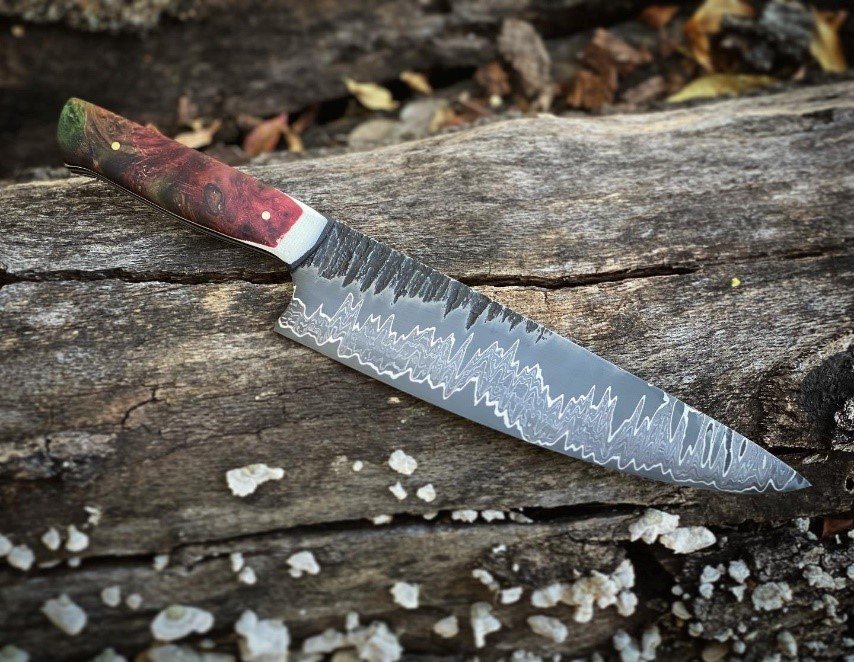Forge Welding Techniques Explained: Go Mai
Last week we learned all about San Mai, the three-layered forging style which has produced some of the most beautiful and durable blades over the centuries. In keeping with our examination of unique forge welding techniques, this week’s topic features the forging style known as Go Mai.
Go Mai is the process of forging five layers of steel to create an incredibly sharp and durable blade. Similar to San Mai, Go Mai originated in Feudal Japan and, when translated from Japanese, simply means “five flat”, a direct reference to the number of layers used in it’s construction. Much like San Mai, Go Mai features distinctive lightening-like streaks down the blade giving it a highly attractive appearance.
The process of forging Go Mai involves taking five pieces of high carbon steel and forge welding them together. As with San Mai, the idea is to wrap a hard, central piece of steel- often Damascus- with more flexible pieces of steel on the outer layers. For the middle two layers, 1084 steel is a popular choice while 15N20 steel is often used for the fourth and fifth layers.
Damascus type steel is often used for the core due to its deadly cutting edge. As we’ve discussed in a previous article, modern-day Damascus is not technically the same as ancient Damascus but has many of the same hard and sharp properties. However, this does come with some disadvantages. Hard steel will cut but isn’t ideal for every application due to its relatively brittle nature. 1084 steel and 15N20 are great for using as outer layers due to 1084’s malleability and 15N20 providing extra strength.
“There are no hard and fast rules about how this blade should be stacked.”
These steels are fantastic for home shops or beginning smiths as they are relatively cheap and easy to work with. However, there are no hard and fast rules about how this blade should be stacked. Many bladesmiths will stack the layers in different combinations or experiment with other types of steel.
Go Mai involves the process of stacking and drawing out heated layers of steel into a proper billet. One of the most crucial precautions bladesmiths should consider is keeping all five layers of the blade aligned during the forge process.
(image credit: Saul Kokkinos Kennedy)
Go Mai blades are then slow cooled, or normalized, at room temperature so they can refine and harden properly. For Go Mai, the normalization process will generally require three cycles of heating and cooling.
Just like San Mai, Go Mai creates a laminated billet. The outer layers of steel coat the inner layers, acting as a shatter resistant layer of protection. One problem bladesmiths may encounter is the laminate peeling off after the forging process. Laminate peeling off the blade indicates cracking; if the imperfections aren’t too deep the smith may cut around the peeling area to salvage the billet. However, at this point many frustrated bladesmiths may find themselves starting over from scratch.
“One of the best features of multi-steel blades is their versatility when compared to mono-steel blades.”
Once the blade is treated and cooled, the blade is cut from the forged billet and smoothed out using a belt sander (40 grit should be adequate to get the rough edges out). Sanding off the finishing touches with some fine steel wool will get the remaining oxides off the surface. Some smiths will then dip the blade in ferric chloride to help emphasize this blade’s unique patterns.
One of the best features of multi-steel blades is their versatility when compared to mono-steel blades. Using only one kind of steel means there will be performance trade-offs, but Go Mai combines the sturdiness and sharpness of all five layers.
(Image credit: Iron Grove Tool Company)
Due to their sharpness and durability, Go Mai blades are a popular choice for kitchens and camp sites. On top of that, they are also exceptional pieces of artwork, and it may be worth picking up one just to add to your collection!
Stick with BRUTE de FORGE as we continue to dig into the techniques used to forge the weapons that forged the world, including our previous deep-dives into Damascus and San Mai. Be sure to follow us on Twitter and Facebook to stay up-to-date with the latest bladesmithing news!
About the Author
More from Chris








